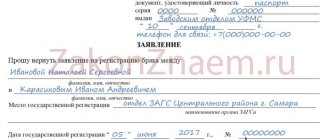Author of the article: Yulia Kaisina Last modified: January 2020 4505
If, after a divorce, one of the spouses does not want to receive financial assistance from the other, he or she has a question: how to withdraw an application for alimony. If a parent wants to refuse child support, the easiest way is not to submit the writ of execution to the bailiff service. When proceedings are already open and money is being withheld, it will be more difficult to stop paying alimony. It is necessary to convince those in charge that this will not infringe on the interests of the child.
Waiver of alimony
Russian legislation does not consider the issue of officially refusing alimony payments. The law states that all actions of parents must not affect the rights of the child.
It happens that one of the parents, due to psychological reasons, refuses to receive child support payments, although their own cash reserve does not contain a large amount of money.
In this case, the guardianship authorities are trying to prove that the child is being kept in unsuitable conditions due to the lack of additional funds allocated for his maintenance. Such a refusal by a parent may result in the deprivation of his parental rights.
Is it possible to withdraw a claim?
The legislation does not provide for such a procedure as formalizing a waiver of rights. The citizen himself makes the decision to realize either the presented opportunities or not. A similar principle is observed when collecting alimony through the court.
It is permissible to withdraw a statement of claim during the paperwork process , but the question of the child’s interests is raised. The court must be presented with compelling reasons for withdrawing the claim for alimony. These include the following factors:
- high level of income of the parent living with the child;
- marriage and improvement of financial situation;
- decrease in the defendant's well-being, temporary or permanent loss of ability to work.
All such aspects are indirect and their significance is determined by the court individually. If there are insufficient grounds, the application for alimony will not be withdrawn. In this situation, payments are forcibly assigned, but their size can be reduced due to the difference in the financial situation of the parents.
To withdraw a claim for alimony during the paperwork process, the plaintiff submits the following documents :
- identification;
- child's birth certificate;
- documentary grounds on which the refusal of the application is issued.
The list of the last item includes a voluntary agreement of the parties on alimony, certified by a notary. Documents on material well-being and wages, and witness testimony are also presented.
Studying the paperwork for collecting alimony, experts emphasize the optionality and impracticality of an application to withdraw documents during the trial process. It makes more sense to ask the court to issue a writ of execution.
Having completed the trial and received a resolution, the plaintiff has the right to independently decide whether to send it along with the application to the bailiffs or not to initiate the collection process. The document is valid for three years from the date of issue, but can be restored in certain circumstances.
Revocation of alimony funds
How to submit an application for alimony and what is needed for this? To request a waiver of alimony for a minor, contact:
- to a notary's office;
- to court;
- to the bailiffs.
The grounds for choosing the method of registration of refusal are:
- stage of the alimony collection process;
- method of collecting funds;
- the presence or absence of a peace agreement between the parties.
Both parties initiate the refusal of alimony payments.
How to refuse alimony
How to submit an application for alimony and what should be taken into account? To revoke a writ of execution or a statement of claim, you need to write a new application for the return of documents.
Collectors most often refuse to receive additional funds for child support in the form of alimony for the following reasons:
- Drawing up a peace agreement with the ex-spouse on voluntary payments;
- In connection with the request of the alimony payer;
- A one-time payment of alimony in exchange for the return of a document.
Bailiffs are not particularly interested in these reasons, so they return documents without problems if all the rules are followed:
- The application is correctly drawn up;
- The plaintiff contacted the FSSP at the place of execution of the claim and left all the documents there for three days until the sheet and document were issued.
This is also important to know:
Child support for an adult child
Before starting the process of waiving alimony payments, be sure to consult with an experienced lawyer so as not to encounter problems in the future.
Application for refusal before trial
This method is the simplest and most peaceful than all the others, since in order not to have to withdraw the claim, you do not need to file it.
Free legal consultation We will answer your question in 5 minutes!
Ask a Question
In order for this decision to become official, it is confirmed with the help of an alimony agreement between the parties. A sample agreement is provided below.
Free legal consultation
We will answer your question in 5 minutes!
Ask a Question
Refusal of alimony payments, regardless of which party is the initiator of this action, must be competently justified and supported by arguments.
The following is a substitute for alimony payments:
- valuable property;
- a one-time large sum of money;
- payment for studies and additional classes.
Not a single notary office will certify an alimony agreement, which indicates a complete refusal of financial assistance from the payer.
How long is the document valid?
Debt can be collected under a writ of execution within a certain period of time. The legislation defines it as three calendar years. The time spent searching for the debtor, obtaining IP by bailiffs, and more is subtracted from it.
If within 3 years the document has not been submitted to the Federal Bailiff Service, then it no longer has any legal force. In this case, you won’t have to think about how to get a writ of execution for alimony. Despite this, the payer's debt still remains. In this regard, it is possible to file a lawsuit again.
The court finds representatives of the FSSP guilty of inaction if the document was submitted on time, but the collection was not made. In this case, the debt will be transferred from the organization itself to the applicant.
Bailiff's decision
The appeal is considered within five days after the bailiff receives the application. Also at this time, a conclusion is made on the satisfaction of the plaintiff’s demands. Next, the enforcement proceedings of the case are suspended, and a resolution is sent to the recipient. After this entire procedure, alimony funds must be paid by the person voluntarily.
Obtaining a writ of execution
The recipient of alimony payments for a child studying at a higher educational institution is given the necessary form immediately after the bailiff makes his decision on the case. A copy of this resolution is also made. Documents are issued upon a personal visit to the bailiff service, as well as through Russian Post.
What does refusal of alimony promise?
The forced collection of alimony payments will cease. Bailiffs will no longer withdraw funds from the payer's wages.
The recipient has the right to file a new claim and a writ of execution to resume the collection of alimony if he does not have enough of his own funds to support the child. The law does not prohibit taking and submitting an application several times. The main thing is that both parties are informed about the issuance of any resolution.
A writ of execution for alimony payments can be submitted to the FSSP authorities at any time before the child reaches the age of majority or when any other compelling reasons arise for stopping the transfer of alimony funds for maintenance.
If you have written a waiver of claims and withdrawn the application, then an application for renewal of collection can only be carried out if significant circumstances and facts for this arise.
Legal consequences of revocation of a writ of execution
It should be said that revoking the writ of execution does not mean abandoning alimony payments. In this case, the collection of alimony is still carried out, which means that the obligation from the alimony payer is not removed.
This is also important to know:
How to get child support for three children and how much money is due for them?
To revoke a writ of execution is simply to replace the forced collection of alimony payments with a voluntary one.
With voluntary collection, alimony funds are paid in the same amount, with the same dynamics and frequency, as with forced collection. Payment reductions are not permitted.
The payer's debt does not increase if the recipient revokes the writ of execution. This means that if the alimony payer refuses voluntary payments, the amount of alimony debt will not increase.
At any time, the recipient of alimony funds has the right to apply to the SSP with the same writ of execution a second time. From the date of filing the relevant application, the judicial proceedings will be started again.
In this court proceeding, current alimony payments and arrears will be forcibly collected.
The law provided for the possibility of collecting alimony for the period when the writ of execution was revoked.
If the recipient of alimony funds provides evidence that the payer did not voluntarily pay the sums of money, then the bailiffs will calculate the amount of the debt (for a period of no more than 3 years). If funds were transferred from the payer, collection of alimony will begin only from the moment the enforcement proceedings are resumed.
How to withdraw an application from court
An application for alimony may be withdrawn before the completion of the trial. To do this, it is necessary to draw up a written refusal of the claim, which will indicate the grounds that prompted this decision. The court will consider the application, and if it does not contradict the interests of the child, the case for collecting alimony payments will be terminated.
The following documents are attached to the application for refusal of the claim:
- Photocopy of the applicant's passport;
- Birth certificate of the minor;
- Writ of execution (if available);
- A notarized agreement between the parties on the waiver of alimony payments, or a receipt for the payment of the entire amount of money for child support.
If a court decision has already been made and alimony has been assigned, the writ of execution is sent to the bailiff service. The recipient must contact a FSSP employee and write a statement to terminate the enforcement proceedings.
The application shall include the following information:
- The name of the FSSP department to which the writ of execution was sent;
- Personal information about the recipient and payer of alimony;
- The name of the court that made the decision and the date it entered into force;
- Date of writing the application to the FSSP to initiate enforcement proceedings;
- Request to revoke the writ of execution;
- Reasoned reasons for the review;
- Signature of the person applying.
The application will be reviewed by bailiffs for a month. After which they will make a decision to suspend the case regarding the collection of alimony payments.
There is another way to refuse alimony after the trial. Having collected the writ of execution from the office, the recipient may not present it to the FSSP. Thus, enforcement proceedings will not be initiated.
If the divorce process has not yet been completed, the plaintiff has the opportunity to withdraw the application for alimony. However, sufficient justification for such a decision will have to be provided. For example, concluding an alimony agreement with the defendant. The mother’s words that she herself is able to provide for the child will most likely not be taken into account by the court. An exception is if the second parent has a difficult financial situation, and he also requests to be exempted from paying child support. If the judge considers that the interests of the child are not violated with such a decision, he can accommodate and return the application for alimony.
Who can be the initiator
The recipient of alimony payments or his official representative has the right to withdraw the application for forced collection.
If the recipient himself does not have the opportunity to represent his interests, for example, if he has not reached the age of majority, then his rights are represented by a trusted representative (parent, guardian, trustee).
If a citizen is able to defend his rights, but does not want to do this on his own, then he has the right to transfer these powers to any other authorized person. To transfer powers, a special power of attorney is drawn up between the parties with the help of a notary.
Who can pick it up
Both the recipient himself and his representative, legal or voluntary, have the right to withdraw an application for forced collection of alimony.
The need for the first arises in cases where the recipient himself does not have sufficient powers to independently represent his interests - he has not reached the age of 18, or has been deprived or limited in legal capacity by the court. And then the responsibility to protect his legal rights arises with the parent, guardian or trustee.
A fully capable citizen, if he does not want to deal with this issue personally, has the opportunity to entrust part of his powers to another person. To do this, he will need to draw up and have the appropriate power of attorney certified by a notary.
Refusal of child support payments in the absence of consent from the second parent
After filing a claim, the refusal of child support payments can be formalized and submitted to the judicial authorities along with all the necessary evidence. Is it possible to withdraw an application for alimony if one of the parties categorically disagrees with it?
To understand the process better, consider practical situations:
Situation 1 . The plaintiff must provide evidence that the child is not an adult, but does not lack funds for his maintenance, since he now lives with a parent who is obliged to pay child support for him by law.
Example 2 . A person who is unable to make alimony payments due to a difficult financial situation, illness or disability must provide appropriate documents to confirm this fact.
Example 3. If the payer is able to provide evidence that the recipient does not have a legal right to alimony, since he is deprived of parental rights, is incompetent, is addicted to drugs, suffers from alcoholism, etc.
Is it possible to withdraw an application for alimony payments?
Although the current legislation does not contain a rule that would contain direct permission that a person has the right to withdraw an application for payments and refuse financial payments for the maintenance of a minor, however, there is also no prohibition on such actions.
It happens that the mother or father withdraws the application for child support and does not want to receive any financial assistance for the maintenance of the minor.
Sometimes this happens even when such a person cannot boast of a financial situation. By the way, if in such a situation the guardianship and trusteeship authority discovers that an adult child is not adequately provided for, he can apply for alimony, despite the parent’s decision. In the worst case, a parent who refuses to pay for a child may lose rights in relation to the latter.
If the rights of the minor are not violated in any way, the parent has the right to freely withdraw the application for child support payments. However, everything will depend on what stage the case is at. Therefore, below we will dwell in detail on how to withdraw an application for alimony.
Re-applying for alimony payments after refusal
If a parent is forced to again demand child support payments from his ex-spouse, then he has a legal right to do so.
The legislation of the Russian Federation allows the renewal of alimony payments until the child reaches adulthood.
You can re-collect alimony in three ways:
- draw up a child support agreement;
- apply to the court for a court order;
- submit a writ of execution to the SSP.
The actions of parents should not in any way infringe on the rights and interests of their child. Alimony payments should only be refused if there are compelling reasons for doing so.
When do bailiffs come into play?
If the alimony payer refuses to transfer money due under a court decision or agreement in favor of the child, the claimant may involve the bailiff service at the defendant’s place of residence in collecting the funds.
The procedure for collecting alimony with the involvement of the FSSP service is as follows:
- Receipt of a writ of execution/court order in court or the presence of a delay in the alimony agreement.
- Appeal to the FSSP with an application to initiate enforcement proceedings.
- Control over the work of bailiffs.
Alas, from time to time the bailiffs are inactive and are not eager to actively collect arrears of alimony, but this is easily stopped by a motivated complaint to management or to the court.
Alimony payments under writ of execution
The legislation of the Russian Federation clearly establishes the income from which alimony payments are deducted. Such income includes most possible types of income.
Free legal consultation We will answer your question in 5 minutes!
Free legal consultation
We will answer your question in 5 minutes!
Ask a Question
Call: 8 800 511-39-66
The deduction occurs as follows:
- First, all types of official income of the payer are determined.
- Income tax is deducted from each income.
- The resulting total amount is used to calculate payments.
This is also important to know:
The minimum amount of alimony and legal grounds for reducing the amount of payments
The amount to be paid by the alimony payer is determined by the judicial authorities. It cannot be more than 70% of his total income.
When the writ of execution is delivered to the bailiff, he performs the following actions:
- Collection proceedings begin.
- Brings information about this to the court, the defendant and the plaintiff.
- Sends a writ of execution to the alimony payer’s place of work.
- Finds out information about the availability of accounts and material assets from the payer.
- Contacts the police department to search for the payer if he is hiding.
- Holds the alimony payer accountable if he evades his obligations.
The received funds are transferred to the recipient's account. In addition to the official amount of alimony, an enforcement fee is also deducted. It is worth considering this information before taking out a writ of execution for alimony.
Can I apply for child support again?
If the child’s mother’s circumstances have changed, she has the right to apply for child support again. This can be done before reaching adulthood.
Alimony is re-assigned in the following cases:
- after a court decision is made;
- upon presentation of the revoked writ of execution.
When applying again, the claimant has the right to claim previous alimony debts.
If you encounter any difficulties in withdrawing your application for alimony, it is recommended that you seek help from a family law lawyer.
Withdraw the claim
Revocation and cancellation of a writ of execution are two different things. The revocation of the writ of execution for alimony is carried out by the claimant himself, and the payer applies to the judicial authorities to cancel the writ of execution. In any case, the claim is justified by compelling reasons for withdrawal or cancellation. For example, a child has recently been permanently living with a child support payer. If a parent wants to cancel the writ of execution, he has the right to ask the court to do so.
The recipient may face the following circumstances due to which he may revoke the writ of execution:
- Conclusion of a voluntary agreement between the parties;
- The parents did not come to a consensus regarding the financial support of the child;
- All alimony payments were replaced by one single payment, but in a large amount.
- Conclusion of a non-property agreement between parents.
The reasons for canceling the writ of execution for alimony are considered separately. In most cases, the child must be competent and prove his or her independence.
A voluntary agreement between former spouses can be concluded at any time before the child reaches adulthood. An agreement is a promissory note certified by a notary. Also, in case of non-fulfillment of payments, the claimant can return the document to forced retention.
Parents are obliged to support the child. Despite this, many parents provoke conflicts in connection with the payment of alimony, so the child’s representatives have to withdraw the writ of execution.
If the payer transferred large property, for example, a house, to the child, or transferred a large sum of money one-time, then he is released from child support obligations.
The defendant is sometimes able to play with parental rights in order to force the withdrawal of the writ of execution. This parental behavior is illegal, but it happens quite often. For example, the father refuses to give consent to the sale of property belonging to the child, or to travel abroad of the Russian Federation. In this case, you should not think about how to revoke the writ of execution for alimony; you just need to go to court and provide evidence of blackmail.
Due to the change of residence of the claimant, the writ of execution cannot be revoked. Inform the bailiff about the fact of the move in writing.
How to withdraw an application for alimony?
The position of family law is based on the interests of the child. However, the claimant may withdraw the claim for alimony, withdraw the writ of execution, or terminate the alimony agreement. The procedure for refusing payments depends on what stage of the registration process you are at. Before doing anything, you should carefully analyze the situation and not act rashly.
How to withdraw a claim before the trial begins?
Withdrawal of a claim is the refusal of the initiator of the dispute to claim the stated or planned legal case. This happens if the situation is resolved peacefully, without the need to contact the servants of Themis.
Sometimes defendants, having received a notice from the court about a summons to a hearing, themselves contact their former spouses and initiate the payment of alimony. In such situations, the plaintiff has the right to withdraw his application, explain the reasons for the refusal and stop the proceedings.
In accordance with Article 39 of the Code of Civil Procedure of the Russian Federation, the applicant has the right to waive claims or change them at each stage of the proceedings . The government agency, in turn, accepts any decision of the plaintiff, if this does not contradict the law.
In order to close a civil case before the start of trial, you must contact the office with an application to abandon the claim. It is recommended to do this before the date of the preliminary hearing. The document will be registered and will be submitted to the judge for consideration. The applicant will have to wait for the decision, for which he will be given an appropriate decree and the statement of claim will be returned.
The procedure takes little time, and you can check the status of completion of the case on the official website of the Supreme Court of the Russian Federation. To do this, you need to know the production number, type and date of receipt of the claim.
How to withdraw a statement of claim during a trial?
If consideration of a claim for alimony has already begun and a preliminary court hearing has taken place, the procedure for returning documents is slightly different.
To revoke the case, the initiator of the case must:
- apply to the court with a motion to waive the claims;
- confirm your intention at the hearing by presenting to the judge a document registered by the office;
- wait for the court's decision;
- take the decision to complete the case into your hands.
The court act can also be received by email. To do this, you need to ask the assistant judge for a copy of the documents.
How to collect a writ of execution from bailiffs?
In practice, cases of revocation of a writ of execution are quite common if the case concerns members of the same family and property.
This can be done because the right to refuse collection and stop taking enforcement measures against the debtor is directly stated in the legislation. However, the procedure for revoking the exacting document does not exempt him from paying the enforcement fee.
The writ of execution issued to collect child support from the alimony is most often revoked. Therefore, doing this is not difficult if a specific enforcement proceeding has a standard form. In some situations, it is not possible to revoke a sheet without the help of a qualified lawyer.
When deciding to close a case with a bailiff, the claimant must decide which procedure he wants to apply:
- termination of the process of execution of a court decision. Involves the complete termination of production, without the possibility of further resumption;
- revocation of writ of execution . It assumes that the claimant retains the right to restore enforcement proceedings during the validity period of the sheet.
In both cases, the claimant must send a corresponding statement to the bailiff who is conducting the proceedings. It is written to the FSSP department and is called “Application for revocation of the writ of execution.”
The form of the document is free, however, it must indicate:
- full name of the department where the bailiff works;
- Full name, information about place of residence and contacts of the debtor and the claimant;
- court decision in the case of alimony collection>;
- a request to revoke the writ of execution, accompanied by an indication of the reasons for such a decision;
- date of application;
- claimant's signature.
It is recommended to prepare two copies of the application, one of which will be handed over to the bailiff for consideration, and the second will remain with the claimant, with a mark on the date of acceptance (affixed in the office of the FSSP department).
From the moment the application is submitted, the bailiff is given 5 working days for its consideration, after which he makes a decision to terminate the enforcement proceedings and returns the sheet to the recoverer (in person or by mail).
It is recommended to revoke a writ of execution only if it is an independent and informed decision of the claimant. Compulsion to such actions (for example, on the part of the debtor) is unacceptable. The applicant must clearly indicate his free will in the text of the petition.
How to pick up an application from the accounting department
Sometimes the claimant does not contact the bailiff service, but takes the writ of execution to the accounting department at the defendant’s place of work in person. In this case, it is enough to write an application for the return of the document addressed to the head of the organization. Only the recipient can do this; the payer will need to obtain permission through the court. But this requires legal grounds: for example, the child moved to live with him or was adopted by the mother’s new husband.
Sometimes accounting employees refuse to return the writ of execution, citing the fact that only the bailiff can revoke it. But if there was no appeal to the FSSP, then there is no enforcement proceedings. Thus, the bailiffs have no relation to the issued document. The claimant may refer to clause 1 of Art. 46 of the Law “On Enforcement Proceedings”, according to which he has the right to revoke the document. If the accounting department refuses to return it, this decision can be challenged in court.
Refusal after entering into a voluntary agreement
In the case of receiving alimony under a notarized alimony agreement, the issue is resolved with the participation of a notary. He certifies the application for refusal of the previously concluded agreement. It should be borne in mind that the notary will check the reasoning of the refusal. A good reason for this may be the conclusion of a new agreement on different terms that do not prejudice the financial situation of the children, or the provision of documents on the transfer to the recipient of a large sum of money or property corresponding to regular payments until the child reaches adulthood (or covering them).
Refusal of child support payments without the consent of the second parent
It is possible to refuse payments for a child by contacting a judicial authority after a claim has been filed. The person must provide the court with significant evidence for this. We invite you to consider illustrative examples.
Example 1. A person is required to prove that a child who has not reached the age of majority does not need additional financial assistance from the mother or father, since he has begun living together with the parent paying child support.
Example 2. The person paying alimony must prove that he is unable to pay the maintenance due to a difficult financial situation, illness or disability.
Example 3. It is necessary to find evidence that the recipient of the payments is not entitled to receive them because he is deprived of parental rights, is incompetent, is addicted to drugs, suffers from alcoholism, etc.
These are just examples and the reasons may vary.
Legal consequences of revocation
The revocation of a writ of execution does not coincide with the refusal of alimony. The claimant himself cannot refuse financial support for the child, since this violates the property rights of the minor. And the revocation of the writ of execution does not relieve the payer from the obligation to support the child. Possible consequences:
- The obligation to support the child remains.
- The alimony debt does not increase, even if there is a debt.
- Enforcement proceedings can be started again at any time the recipient wishes.
- Revocation does not clear the debt.
Will the debt remain if you take away the writ of execution for alimony?
If the person who pays alimony has a payment debt, due to the revocation of the writ of execution, the debt will not be cancelled. This means that the debt obligation, in any case, remains with the person. However, forced collection is being replaced by voluntary repayment. Along with this, the withdrawal of the writ of execution and the end of the proceedings stop the growth of the debt.
After the writ of execution is withdrawn, the recipient of the payments again has the right to go to the bailiff service with a request to resume proceedings. From this moment on, all debt will be collected again forcibly.
At the legislative level, it is possible to recover payments for the period during which enforcement proceedings were suspended and the corresponding document was revoked. So, if a person receiving alimony payments for child support proves that during a certain period of time financial resources were not transferred to his account voluntarily, the bailiff service employees are authorized to make a calculation of the debt for the entire period (no more than three years) .
If all this time payments from the payer have been regularly received into the account of the claimant, alimony will be collected only from the period of renewal of the case. Those who want to avoid compulsory collection of child support should take care of collecting evidence of voluntary payments of funds. So, it is better for the alimony payer to collect bank statements, receipts, checks for payments, receipts from the claimant for receipt of payments, etc.
Additionally
Abandonment of a child may mean no obligation to pay child support.
It happens that a parent, whose responsibility is to pay child support, thinks about giving it up. It is worth mentioning that in Russian legislation there is no such concept of “child abandonment,” excluding the mother’s right to leave the baby in the maternity hospital immediately after birth.
This is also important to know:
Calculation of alimony penalties - online calculator 2020, how to calculate
The birth of a child imposes certain responsibilities on parents and it is prohibited to voluntarily renounce them.
There are several cases when parents lose their rights to a child, but even they do not always exempt them from paying child support:
- Lack of communication with the child, as well as waiver of parental rights (alimony is still collected until the child is adopted, for example, by a stepfather or stepmother).
- Challenging parental rights.
Consequences of deprivation of parental rights and abandonment of a child:
- Loss of the opportunity to participate in the child’s life and raise him;
- Loss of rights to meet with the baby;
- Obligation to pay child support until adulthood or death.
There are no significant advantages to abandoning a child - only disadvantages and even more stringent and complex conditions. A parent who maintains at least some contact with the child can still count on the leniency of the claimant or the court in the event of a delay in child support payments, but one deprived of all rights to the child is unlikely to arouse pity from the other parent or the judge.
How to get alimony if you have previously refused it
If one day the recipient of alimony funds refused them due to one reason or another, and after some time realized that without additional amounts of money it was impossible to properly support the child, he has the right to demand the restoration of payments.
The situation when the plaintiff again submits an application for the return of the alimony obligation to the payer is associated with various reasons: the illness of the recipient or the loss of a permanent source of funds. This can also happen if the child urgently needs a medical examination, treatment, medication, payment for studies, etc.
Parents, having agreed, can refuse the previous alimony agreement and draw up a waiver of alimony. Cancellation is carried out in a similar way.
At the end, an agreement is drawn up, which displays the conditions, terms and amount of payments for the child. The main thing is that both parents make a mutual decision on this issue, and also preserve all the rights and interests of the child.
If one of the parents, who is the recipient of alimony funds for the maintenance of a child, refuses financial assistance, then the renewal of collection can be demanded at any time before the child reaches the age of majority. This is done by filing a claim with the courts. After the court decision is made, the plaintiff goes to the bailiff service and shows them the court order, which will serve as the basis for initiating proceedings in the case.
If the defendant has already withdrawn the claim once, then the official document on alimony from the bailiffs must be renewed, and this is done by providing a writ of execution.
Can a bailiff refuse to accept an application to revoke a writ of execution?
No, this is not within his authority. Moreover, the recipient of alimony funds himself determines what will happen in the future with the writ of execution and his own rights.
The bailiff must explain the consequences of withdrawing the writ of execution, as well as the procedure for filing it again, if necessary.
It is important that the three-year period for presenting a document for execution does not apply to the payer’s alimony obligations!
Receiving alimony after refusal
Circumstances may develop in such a way that the parent who refused child support will have reasons to again receive legal child support. The reasons are: deterioration of financial situation, illness of the child, payment of tuition.
There are several ways to resume payments:
- Termination of the agreement on refusal to pay alimony. The parties enter into a new agreement, which specifies the amount of payments, terms and procedure for their payment.
- Applying to the court with a claim for alimony. You can submit an application if the child’s mother refused benefits during the divorce proceedings.
- Providing a writ of execution to the FSSP. Bailiffs are obliged to resume the case for the collection of alimony upon presentation of a writ of execution after revocation.
What happens after the writ of execution is revoked
Let us note that after the revocation of the writ of execution, the claimant retains the right to re-submit the writ for execution throughout the entire period of alimony collection, until the child reaches adulthood, and for three years after the end of this period.
Parents are obliged to support their children not only by force of law, but also by force of the natural way of life. Often, mothers simply despair of trying to get at least some amount from the child’s father, and therefore want to refuse child support.
However, motherhood and childhood in our country are under state protection, and every year legislation is being improved in this direction. For example, since 2020, not only criminal, but also administrative liability for non-payment of alimony has been in effect (Article 5.35.1 of the Code of Administrative Offenses of the Russian Federation, Article 157 of the Criminal Code of the Russian Federation).











